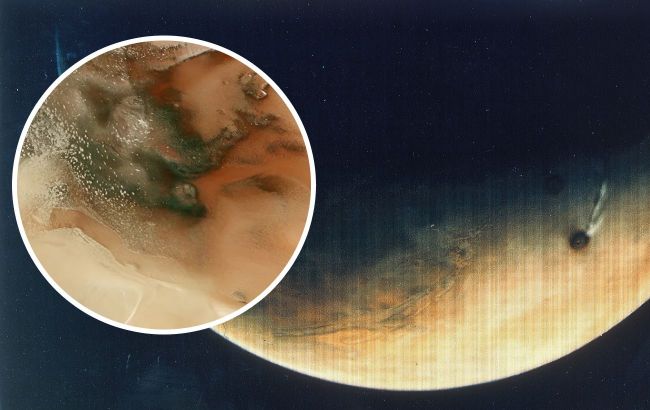Cryptic Mars terrain revealed in stunning new photos
 Mysterious terrain puzzled scientists (collage: RBC-Ukraine)
Mysterious terrain puzzled scientists (collage: RBC-Ukraine)
The European Space Agency's (ESA) Mars Express spacecraft has transmitted new images of the southern polar region of Mars, revealing features known as cryptic terrain emerging from beneath the planet's ice, according to IFLScience.
Mars' polar regions through three seasons
A mixture of carbon dioxide and water ice covers the polar areas of Mars. In the fall, as the planet cools, these gases condense around the ice caps, creating additional layers of ice. During the Martian winter, the ice caps grow significantly.
"By late winter, they may even reach as far as 55 degrees latitude – roughly the equivalent of Scotland and Denmark’s southern reaches if translated to the northern hemisphere of Earth," ESA explained in a blog post.
In the spring, carbon dioxide ice does not melt but sublimates, transforming directly from a solid to a gas without an intermediate liquid phase, continuing the cycle.
What is known about cryptic terrain
When scientists first started receiving images from Mars, they noticed some unusual features, one of which was simply called cryptic terrain because it defied explanation at the time.
These features appear as areas of significantly darker terrain that stand out against the backdrop of the Martian ice caps.

The cryptic terrain in Australe Scopuli on a topographic image (photo: European Space Agency)

The dark patches are what we now call cryptic terrain (photo: European Space Agency)
Although these regions initially seemed puzzling, scientists have since developed several hypotheses and now understand how they formed.
"When sunlight penetrates through the translucent carbon dioxide ice layer in early spring, it warms up the underlying surface. The ice at the bottom of the layer begins to sublimate, creating pockets of trapped gas. The pressure builds up, and the overlying ice suddenly cracks. Jets of gas burst through the surface, carrying dark dust from below. The dust falls back to the surface in a pattern shaped by the direction of the prevailing wind," the ESA explains.

Cryptic terrain forms in perspective (photo: European Space Agency)
This mechanism is similar to the one scientists believe likely formed the famous "spiders on Mars," which are found only in the same region of the Red Planet, at least based on available images.
Once the dust settles, the dark spots absorb more sunlight, gradually sinking through the ice and forming holes.
"Either fresh ice is revealed underneath, or new frost may then condense on top of the sinking dark grains, resulting in a bright fan at the place of the initially dark fan," the ESA adds.
This mechanism is similar to the one proposed for Mars' spiders, and recent experimental evidence supports it.
Read also about eight cool places on Mars that future tourists could visit.
In addition, we also published about the discovery of a giant object on Mars that could hide water.

